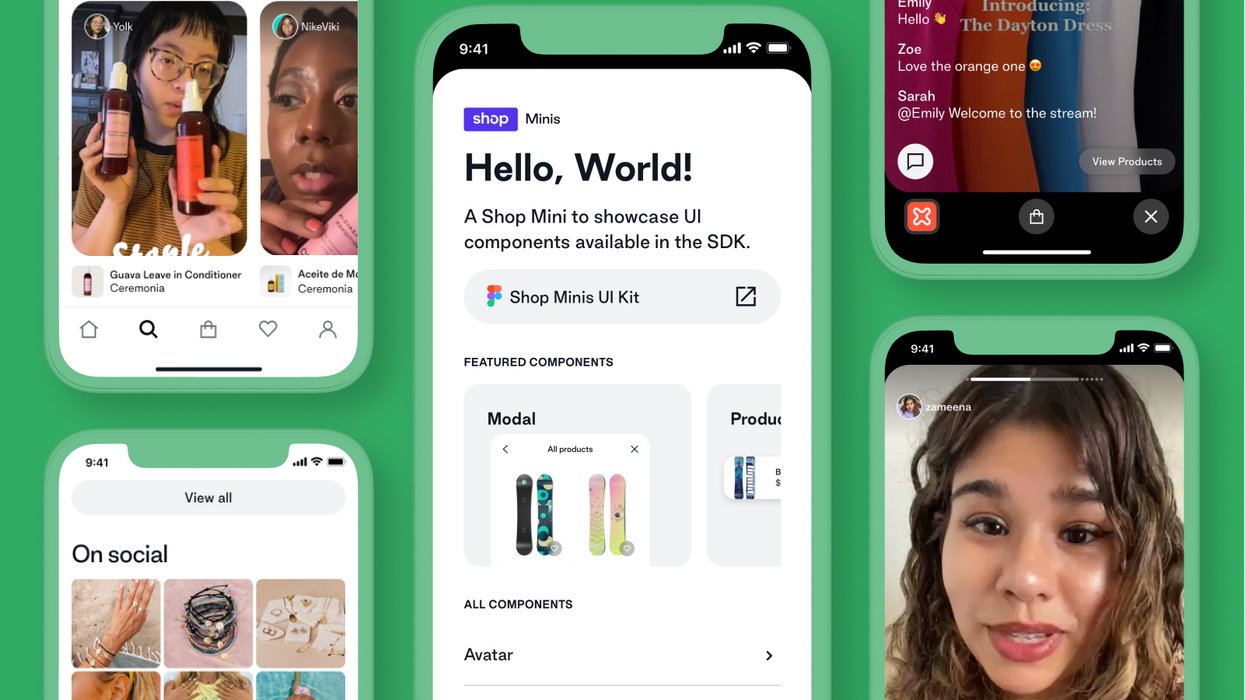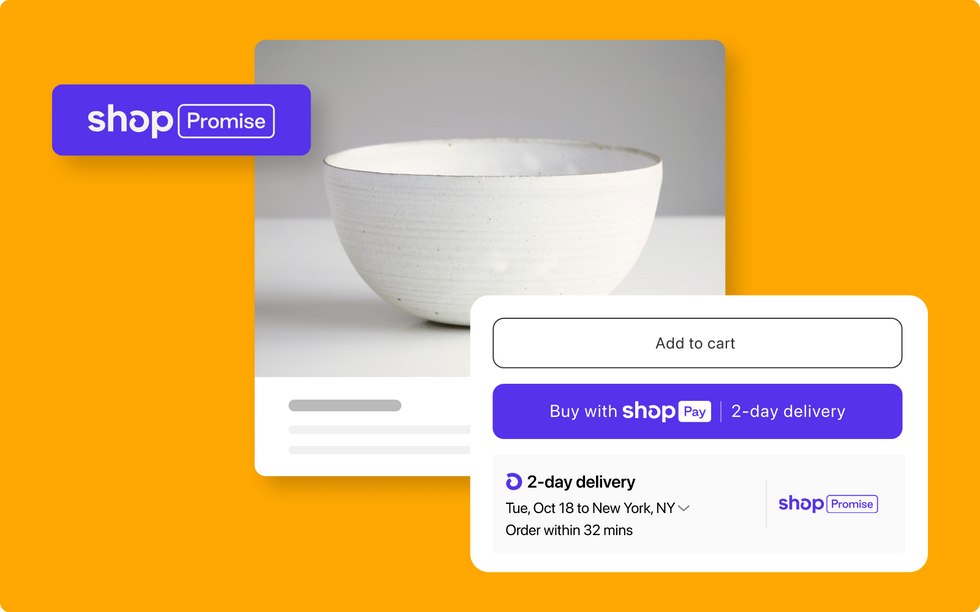Retail Channels
09 February 2023
Shopify drops 100+ upgrades, from the Shop app to one-page checkout
Shopify Editions features deeper fulfillment integrations.

Shopify Editions includes dev tools for the Shop app. (Courtesy photo)
Shopify Editions features deeper fulfillment integrations.

Shopify Editions includes dev tools for the Shop app. (Courtesy photo)
Shopify dropped details on more than 100 new product releases Thursday.
The second release of Shopify Editions features upgrades to the Shop app and checkout. The Winter ‘23 Edition also aims to build deeper supply chain and fulfillment integrations, underscoring that Shopify wants to do more to help merchants not only sell products, but also deliver them.
“We need to be the fastest moving commerce company in the world because our merchants depend on Shopify’s innovation for their own longevity," said Shopify President Harley Finkelstein, in a statement. "So with this Edition, we moved quickly to offer tools that help merchants access the promise of mobile commerce, meet customer expectations for seamless checkout and fast delivery, and convert better—it’s the best version of Shopify yet, and will shape the future of entrepreneurship.”
Here’s a look at key updates:
Shopify launched the Shop app in 2020 to provide checkout and order tracking for merchants. With the latest upgrades, the company is signaling it wants to continue to evolve the app into a more complete mobile commerce experience that is not only for checkout and post-purchase, but also discovery and browsing.
The latest offerings include:
The Shop Mini software development kit, which is designed for developers to extend the functionality of a web-based Shopify store to the Shop app.
Shop Store customizations are designed to allow merchants to create a larger owned brand presence on the app. This includes the ability to customize product collections, best sellers, reviews and branding.
Shop Cash campaigns provide Shopify Plus merchants with a way to target shoppers who use the Shop Cash rewards program with special offers. “Merchants only pay when a customer is acquired, and the cost-per-acquisition (CPA) never goes above their predetermined parameters,” Shopify writes.
Sign in with Shop: Consumes will get access to biometric passkeys, the ability to follow a merchant on Shop. Meanwhile, merchants will be able to access lead capture tools such as automatically signing in high-value shoppers and offering a personalized experience.
One-page checkout will become the default for Shopify’s checkout experience. Shopify said this is optimized based on learnings from Shop Pay. It builds on a checkout experience that frequently wins plaudits.
Checkout extensions introduced in the first Shopify Editions are already being improved. Shopify is providing a Checkout Editor to make it easier to add functionality to checkout with a drag-and-drop experience. It is also adding dev tooling, including the ability to build bespoke checkout apps.

Shop Promise. (Courtesy photo)
As Shopify rolls out upgrades to the Shopify Fulfillment Network following the May 2022 acquisition of Deliverr, it is also introducing Shop Promise. It’s a badge that appears at checkout to guarantee two-day delivery. Now, the badge is automatically enabled for merchants that use the fulfillment network.
Shopify also introduced a new Flexport app for ocean freight booking and tracking, and a new integration with Loop Returns that allows merchants to offer instant exchanges and credits. Shopify said it also now has unified its existing fulfillment network with Deliverr to allow for data-driven inventory distribution that positions inventory close to demand.
There's lots more to discover in the release. A number of the features detailed in the Shopify Editions update were previously rolled out by the company. Take a look at past coverage:
Can Shop Cash entice more users to use the app for browsing and buying?
Shopify is launching a new rewards program for items purchased through its checkout system.
Shop Cash will provide the opportunity for consumers to earn 1% back on purchases made through Shop Pay.
The feature includes a direct tie-in with the Shop app. Users can check their balance through the app, and the rewards are redeemable for future purchases through Shop, as well.
“This is a coming of age moment for Shop. It’s become an incredible app that allows shoppers to discover great brands, check out with one tap, and track orders in real time,” said Harley Finkelstein, president of Shopify, in a statement. “Shop Cash represents the next evolution of Shop, connecting independent brands to more shoppers, and rewarding those shoppers for being loyal fans.”
The launch falls on Shopify’s 17th birthday, so the ecommerce software company is giving away Shop Cash to celebrate. For Shop Day, Shopify partnered with dozens of merchants, including Trixie Cosmetics, MrBeast and Monday Swimwear. They’ll share custom links across channels that offer cash to spend on the Shop app. In all, Shopify will give away more than $1,000,000. Brands will also be running exclusive Shop Cash offers throughout the day.
The rewards program marks a new way that Shopify is aiming to transform Shop into more of a shopping app where users can discover new items, extending beyond its initial use for post-purchase order tracking and management at launch in 2020.
Shopify has been making moves over the last year to provide more opportunities to browse and buy recommended products, as well as giving brands more tools to showcase storefronts and tell their stories. With Shop Pay, the app offers one-click checkout. There are signs that it is all inspiring users to seek out the app. Shopify said 35% of the orders on the Shop app are repeat purchases.
With more brands joining the app and infrastructure for the shopper experience and checkout in place, rewards can help make the app stickier for consumers. The opportunity to earn cash, redeem it and even check a rewards balance are all reasons to keep returning to the app, and make it a destination to shop.
Shopify has long been known as the infrastructure layer of commerce, as it provided the tools for brands to run and manage an online store under their own name. With the Shop app, it is aiming to make Shopify itself a destination for shopping. It remains a nascent effort, even as more brands have taken advantage of the new features to enhance storefronts.
This comes as marketplaces continue to rise across ecommerce, and giants like Amazon and Walmart experiment with tools that do more to boost discovery of new products.
Social media has long been the engine of discovery in ecommerce, especially in the direct-to-consumer realm that Shopify has owned. Users found products on Facebook or Instagram, then finished checkout on a brand's phase. With the push toward privacy making performance marketing more difficult and customer acquisition costs rising, the ecommerce platforms are attempting to take that power into their own hands. With advertising placed close to the point of sale through retail media and the ability to check out on the same page where a user sees a product, marketplaces and Shop are realizing new opportunities to attract, convert and deliver for users within one app. For Shop, the trick is to attract more shoppers to the app. Rewards like Shop Cash are a carrot to do just that.